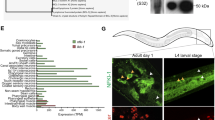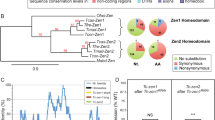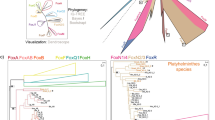Abstract
RUNX proteins are evolutionarily well-conserved transcription factors that are involved in essential aspects of the development of metazoan animals ranging from nematodes to humans. Genetic or epigenetic defects in any one of the three RUNX proteins in humans cause severe diseases. Although much is known about the functions and signaling pathways of the RUNX proteins through the use of mammalian systems, there are still gaps in our knowledge with regard to the functions of the RUNX proteins in normal development and disease states. Recently, the nematode Caenorhabditis elegans was revealed to bear one RUNX homolog (RNT-1) and one homolog of the RUNX protein partner CBFβ/PEBP2β (BRO-1). The expression patterns and biological functions of RNT-1 and the manner in which it is regulated are all comparable to what has been observed for the mammalian RUNX proteins. Thus, the nematode system is a promising model system for elucidating the functions and regulation of Runt proteins. In addition, it has recently emerged that the RNT-1 protein is involved in a transforming growth factor beta signaling pathway. The bro-1 gene encoding the CBFβ homolog is exclusively expressed in the hypodermis, not in the intestine, which indicates that additional tissue-specific cofactors in the intestine might exist. The possible autoregulation of RNT-1 expression by RNT-1/BRO-1 in the hypodermal cells is also discussed.
This is a preview of subscription content, access via your institution
Access options
Subscribe to this journal
Receive 50 print issues and online access
$259.00 per year
only $5.18 per issue
Buy this article
- Purchase on Springer Link
- Instant access to full article PDF
Prices may be subject to local taxes which are calculated during checkout



Similar content being viewed by others
References
Aroian RV, Koga M, Mendel JE, Ohshima Y and Sternberg PW . (1990). Nature, 348, 693–699.
Aronson BD, Fisher AL, Blechman K, Caudy M and Gergen JP . (1997). Mol. Cell. Biol., 17, 5581–5587.
Bae SC and Lee J . (2000). Gene, 241, 255–258.
Bae SC, Takahashi E, Zhang YW, Ogawa E, Shigesada K, Namba Y, Satake M and Ito Y . (1995). Gene, 159, 245–248.
Bae SC, Yamaguchi-Iwai Y, Ogawa E, Maruyama M, Inuzuka M, Kagoshima H, Shigesada K, Satake M and Ito Y . (1993). Oncogene, 8, 809–814.
Bowtell DD and Langdon WY . (1995). Oncogene, 11, 1561–1567.
Brenner S . (1974). Genetics, 77, 71–94.
Broome MA, Galisteo ML, Schlessinger J and Courtneidge SA . (1999). Oncogene, 18, 2908–2912.
Caenorhabditis elegans Genome Consortium (1998). Science, 282, 2012–2018.
Coffman JA . (2003). Cell Biol. Int., 27, 315–324.
Drissi H, Luc Q, Shakoori R, Chuva De Sousa Lopes S, Choi JY, Terry A, Hu M, Jones S, Neil JC, Lian JB, Stein JL, Van Wijnen AJ and Stein GS . (2000). J. Cell. Physiol., 184, 341–350.
Estevez M, Attisano L, Wrana JL, Albert PS, Massague J and Riddle DL . (1993). Nature, 365, 644–649.
Galisteo ML, Dikic I, Batzer AG, Langdon WY and Schlessinger J . (1995). J. Biol. Chem., 270, 20242–20245.
Gergen JP and Wieschaus EF . (1985). Dev. Biol., 109, 321–335.
Han M, Aroian RV and Sternberg PW . (1990). Genetics, 126, 899–913.
Han M, Golden A, Han Y and Sternberg PW . (1993). Nature, 363, 133–140.
Hill RJ and Sternberg PW . (1992). Nature, 358, 470–476.
Hime GR, Dhungat MP, Ng A and Bowtell DD . (1997). Oncogene, 14, 2709–2719.
Hopper NA, Lee J and Sternberg PW . (2000). Mol. Cell, 6, 65–75.
Hwang SB and Lee J . (2003). J. Mol. Biol., 333, 237–247.
Imai Y, Kurokawa M, Tanaka K, Friedman AD, Ogawa S, Mitani K, Yazaki Y and Hirai H . (1998). Biochem. Biophys. Res. Commun., 252, 582–589.
Jongeward GD, Clandinin TR and Sternberg PW . (1995). Genetics, 139, 1553–1566.
Kagoshima H, Shigesada K, Satake M, Ito Y, Miyoshi H, Ohki M, Pepling M and Gergen P . (1993). Trends Genet., 9, 338–341.
Kania MA, Bonner AS, Duffy JB and Gergen JP . (1990). Genes Dev., 4, 1701–1713.
Kataoka H, Ochi M, Enomoto K and Yamaguchi A . (2000). Mech. Dev., 98, 139–143.
Krishna S, Maduzia LL and Padgett RW . (1999). Development, 126, 251–260.
Levanon D, Goldstein RE, Bernstein Y, Tang H, Goldenberg D, Stifani S, Paroush Z and Groner Y . (1998). Proc. Natl. Acad. Sci. USA, 95, 11590–11595.
Levanon D, Negreanu V, Bernstein Y, Bar-Am I, Avivi L and Groner Y . (1994). Genomics, 23, 425–432.
Li FQ, Person RE, Takemaru KI, Williams K, Meade-White K, Ozsahin AH, Gungor T, Moon RT and Horwitz M . (2004). J. Biol. Chem, 279, 2873–2884.
Li QL, Ito K, Sakakura C, Fukamachi H, Inoue K, Chi XZ, Lee KY, Nomura S, Lee CW, Han SB, Kim HM, Kim WJ, Yamamoto H, Yamashita N, Yano T, Ikeda T, Itohara S, Inazawa J, Abe T, Hagiwara A, Yamagishi H, Ooe A, Kaneda A, Sugimura T, Ushijima T, Bae SC and Ito Y . (2002). Cell, 109, 113–124.
Lupher Jr ML, Andoniou CE, Bonita D, Miyake S and Band H . (1998). Int. J. Biochem. Cell Biol., 30, 439–444.
Lupher Jr ML, Reedquist KA, Miyake S, Langdon WY and Band H . (1996). J. Biol. Chem., 271, 24063–24068.
Mao S, Frank RC, Zhang J, Miyazaki Y and Nimer SD . (1999). Mol. Cell. Biol., 19, 3635–3644.
Martensson A, Xie XQ, Persson C, Holm M, Grundstrom T and Martensson IL . (2001). Eur. J. Immunol., 31, 3165–3174.
McCarthy TL, Ji C, Chen Y, Kim KK, Imagawa M, Ito Y and Centrella M . (2000). J. Biol. Chem., 275, 21746–21753.
Meisner H, Daga A, Buxton J, Fernandez B, Chawla A, Banerjee U and Czech MP . (1997). Mol. Cell. Biol., 17, 2217–2225.
Miyake S, Lupher Jr ML, Andoniou CE, Lill NL, Ota S, Douillard P, Rao N and Band H . (1997). Crit. Rev. Oncogene, 8, 189–218.
Miyoshi H, Kozu T, Shimizu K, Enomoto K, Maseki N, Kaneko Y, Kamada N and Ohki M . (1993). EMBO J., 12, 2715–2721.
Montgomery MK, Xu S and Fire A . (1998). Proc. Natl. Acad. Sci. USA, 95, 15502–15507.
Morita K, Chow KL and Ueno N . (1999). Development, 126, 1337–1347.
Morita K, Flemming AJ, Sugihara Y, Mochii M, Suzuki Y, Yoshida S, Wood WB, Kohara Y, Leroi AM and Ueno N . (2002). EMBO J., 21, 1063–1073.
Nam S, Jin YH, Li QL, Lee KY, Jeong GB, Ito Y, Lee J and Bae SC . (2002). Mol. Cell. Biol., 22, 547–554.
Ogawa E, Inuzuka M, Maruyama M, Satake M, Naito-Fujimoto M, Ito Y and Shigesada K . (1993a). Virology, 194, 314–331.
Ogawa E, Maruyama M, Kagoshima H, Inuzuka M, Lu J, Satake M, Shigesada K and Ito Y . (1993b). Proc. Natl. Acad. Sci. USA, 90, 6859–6863.
Okuda T, van Deursen J, Hiebert SW, Grosveld G and Downing JR . (1996). Cell, 84, 321–330.
Otto F, Lubbert M and Stock M . (2003). J. Cell Biochem., 89, 9–18.
Patterson GI and Padgett RW . (2000). Trends Genet, 16, 27–33.
Savage C, Das P, Finelli AL, Townsend SR, Sun CY, Baird SE and Padgett RW . (1996). Proc. Natl. Acad. Sci. USA, 93, 790–794.
Smit L and Borst J . (1997). Crit. Rev. Oncogene, 8, 359–379.
Suzuki Y, Yandell MD, Roy PJ, Krishna S, Savage-Dunn C, Ross RM, Padgett RW and Wood WB . (1999). Development, 126, 241–250.
Wang S, Wang Q, Crute BE, Melnikova IN, Keller SR and Speck NA . (1993). Mol. Cell. Biol., 13, 3324–3339.
Wotton D, Ghysdael J, Wang S, Speck NA and Owen MJ . (1994). Mol. Cell. Biol., 14, 840–850.
Yoon CH, Lee J, Jongeward GD and Sternberg PW . (1995). Science, 269, 1102–1105.
Zhang DE, Hetherington CJ, Meyers S, Rhoades KL, Larson CJ, Chen HM, Hiebert SW and Tenen DG . (1996). Mol. Cell. Biol., 16, 1231–1240.
Acknowledgements
Our studies described in this review were supported by a Biodiscovery Grant (M1-0311-00-0034) to J Lee and by the Creative Research Program (M10301000012) funded by the Ministry of Science and Technology of Korea to S-C Bae. We are also grateful to all the members of their labs for support and critical evaluation of this paper, especially S Nam, J Shim, and Y Ji.
Author information
Authors and Affiliations
Corresponding author
Rights and permissions
About this article
Cite this article
Lee, J., Ahnn, J. & Bae, SC. Homologs of RUNX and CBFβ/PEBP2β in C. elegans. Oncogene 23, 4346–4352 (2004). https://doi.org/10.1038/sj.onc.1207669
Published:
Issue Date:
DOI: https://doi.org/10.1038/sj.onc.1207669
Keywords
This article is cited by
-
The Runx transcriptional co-activator, CBFβ, is essential for invasion of breast cancer cells
Molecular Cancer (2010)
-
Genetic evidence of PEBP2β-independent activation of Runx1 in the murine embryo
International Journal of Hematology (2008)
-
Transcription factors T-bet and Runx3 cooperate to activate Ifng and silence Il4 in T helper type 1 cells
Nature Immunology (2007)
-
Alternative splicing removes an Ets interaction domain from Lozenge during Drosophila eye development
Development Genes and Evolution (2005)



